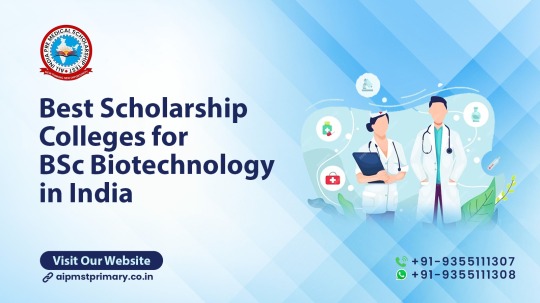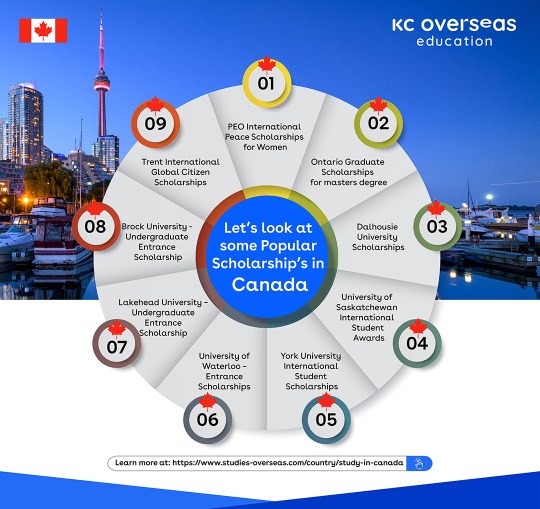#scholarship in canada
Text
4 notes
·
View notes
Text
Best Scholarship Colleges for BSc Biotechnology in India

Best colleges for BSc Biotechnology can be an exciting and rewarding journey, offering opportunities for cutting-edge research and innovation. Scholarships are an excellent way to ease the financial burden and make your academic dreams a reality. We explore some of the best scholarship colleges in India that offer BSc Biotechnology programs. If you want to read more click here…..
#career in biotechnology#biotechnology#bsc biotechnology#biotechnology career#biotechnology jobs#biotechnology career in india#scholarship in canada#scholarship#top 5 biotechnology scholarships#100% scholarship#biotechnology career after 12th#list of biotechnology scholarships#bsc in biotechnology#msc biotechnology global scholarships#top global biotechnology scholarships#study in canada scholarship for international students#ms in biotechnology
0 notes
Text
Vector Scholarship In Canada for AI Students
The Vector Scholarship in Artificial Intelligence (AI) aims to attract outstanding students to AI master’s programs in Ontario. It offers a $17,500 Canadian dollars entrance scholarship to top-performing Students who are studying in AI Master’s programs at Ontario Universities or are pursuing a personalized study path with a strong focus on Artificial Intelligence (AI). These scholarships are…

View On WordPress
#Scholarship for AI Students#Scholarship in Canada#Vector Scholarship#Vector Scholarship In Canada for AI Students
0 notes
Text

"Step Outside Your Comfort Zone and Discover the World with Our Study Abroad Services!"
#study abroad#study in canada#overseas education#study in usa#study in uk#study abroad australia#study abroad to usa#scholarship in canada#scholarships in australia#study in australia
0 notes
Link
Canada may be one of the most desirable places for international students, but studying here is not inexpensive. Overseas students in need of financial aid can apply for a Scholarship in Canada to further their education.
0 notes
Text
Secured Top 10 Ongoing Scholarship In The Canada 2023
Top 10 ongoing Scholarship in the Canada are an excellent way to help you pursue your educational goals. In Canada, there are thousands of scholarships worth millions of dollars every year; however, finding them can be tough if you don’t know where to look or what to look for. Many are only available to students in specific programs or in specific regions and aren’t announced publicly. To help…

View On WordPress
0 notes
Photo

Is Canada is your dream study location and you are looking for scholarship opportunity for higher education. Here's an overview of some of the top scholarships in Canada for international students.
0 notes
Text






a current day nils and a 90s college student nils who's way too intense about his internship walk into a bar
#hiiiiiiiiiiiiiii nils hiiii 💗🤭#let me get my important tags out of the way so i can write you a novella in the rest of them#ts4#ts4 cas#ts4 edit#the sims 4#nils#i've been exploring his character 🏃♂️#his full name is nils pelletier he's from canada originally he went to nyc for college and stayed there forever#he didn't grow up with much but he was really good at school so he got a scholarship and he was very very determined to become rich#he interned at frankie's dad's company and was offered a full time position after he graduated yayy you made it. i guess :| (evil company)#he's always been very stern very serious very quiet he's never had many if any friends. he was a deeply unhappy child#his parents weren't even bad they're nice and supportive and tried their best#he was married and has one son but he hasn't been married for a while. i don't know if it's divorce or death or what yet#it was the first girl he ever had a relationship with and he was also her first relationship#a very dull marriage but again not a bad one. she was nice and supportive and tried her best#it seemed like it was what they were supposed to do. get married and have a child bam done you did what was expected congrats#they barely ever even argued it was just. well loveless seems a harsh word. and 'well they were friends at least' seems untruthful#anyway he often has to be frankie's handler because frankie's dad is his boss and he does what he's told always#frankie's really difficult though
164 notes
·
View notes
Text
How tech does regulatory capture

If you want to know which industries have the most influence in DC, study the trade deals struck by the US Trade Representative, whose activities are the most obvious manifestation of American corporate power over state. Take the Indo-Pacific Economic Framework (IPEF). As David Dayen notes, this treaty is a kind of Big Tech wishlist:
https://prospect.org/power/2023-04-18-big-tech-lobbyists-took-over-washington/
If you’d like an essay-formatted version of this post to read or share, here’s a link to it on pluralistic.net, my surveillance-free, ad-free, tracker-free blog:
https://pluralistic.net/2023/04/18/cursed-are-the-sausagemakers/#how-the-parties-get-to-yes
The USTR’s playbook has changed over the years, reflecting the degree of control over the US government exerted by different sectors of the US economy. Today, with Big Tech in the driver’s seat, US trade deals embody something called the “digital trade agenda,” a mix of policies ranging from limiting liability, privacy protection, competition law, and data locatization.
The Digital Trade Agenda is a relatively new phenomenon. A decade ago, when the USTR went abroad to twist the arms of America’s trading partners, the only “digital” part of the agenda was obligations to spy on users and to swiftly remove materials claimed to have violated US media monopolies’ copyright. But as the tech sector grew more concentrated, they were able to seize a greater share America’s trade priorities.
One person who had a front-row seat for this transformation was Wendy Li, a PhD candidate in sociology at the University of Wisconsin, who served in the USTR’s office from 2015–17, and who leveraged her contacts among officials and lobbyists (and ex-lobbyists turned officials and vice-versa) to produce a fascinating, ethnographic account of a very specific form of regulatory capture. That account appears in “Regulatory Capture’s Third Face of Power,” in Socio-Economic Review. The article is paywalled, but if you access it via this link, you can bypass the paywall:
https://pluralistic.net/wendi-li-reg-capture
Li’s paper starts with a taxonomy of types of regulatory capture, drawn from the literature. The first kind — the “first face of power” — is when an industry wins some battle over a given policy, triumphing over the public interest. Li notes that defining “public interest” is sometimes tricky, which is true, but still, there are some obvious examples of this kind of capture.
My “favorite” example of horrible regulatory capture is from 2019, when Dow Chemical — working through the West Virginia Manufacturers Association — convinced the state of West Virginia to relax the limits on how much toxic runoff from chemical processing could be present in the state’s drinking water. Dow argued that the national safe levels reflected a different kind of person from the typical West Virginian. Specifically, Dow argued, the people of West Virginia were much fatter than other Americans, so their bodies could absorb more poison without sickening. And besides, Dow concluded, West Virginians drink beer, not water, so poisoning their drinking water wouldn’t affect them:
https://washingtonmonthly.com/2019/03/14/the-real-elitists-looking-down-on-trump-voters/
This isn’t even a little ambiguous. Dow’s pleading wasn’t just absurd on its face — it was also scientifically bankrupt — there’s no evidence that being overweight makes you less susceptible to carcinogens. And yet, the state regulator bought it. Why? Well, maybe because chemical processing is WV’s largest industry, and Dow is the largest chemical company in the state. Regulatory capture, in other words.
The second kind of regulatory capture is the “revolving door”: when an executive from industry rotates into a role in government, where they are expected to guard the public interest from their former employers. There’s some of this in every presidential administration — think of Obama’s ex-Morganstanley and ex-Goldmansachs finance officials.
But while Obama and other “normal” pols sketched their corruption with a fine-tipped pen, making the overall shape hard to discern, Trump scrawled large, crude, unmissable figures with a fisted Sharpie. Remember Scott Pruitt, the disgraced Trump EPA who wanted to abolish the EPA? Pruitt was was such a colossal asshole that even the lobbyists who’d been bribing him with free housing actually evicted him:
https://www.cnn.com/2018/04/06/politics/pruitt-trump/index.html
After Pruitt resigned in the midst of chaotic scandal, he was succeeded by his deputy, Andrew Wheeler — a former coal lobbyist:
https://www.nytimes.com/2018/07/05/climate/scott-pruitt-epa-trump.html
That’s the “second face of power.” What’s the third? It’s taking over the shape of the debate, getting to define its axioms. Think of the reflexive idea that government projects are “wasteful” and “inefficient.” Once all players internalize this idea, the debate shifts from “what should the public sector do?” to “which private-sector entity should the government pay to do this?” Anyone who says, “Wait, why doesn’t the government just do this?” just gets blank stares.
We can see this in the cramped and inadequate debate over the SVB bailout; apologists for the bailout insist that it was necessary because if SVB’s depositors had been forced to take a haircut, every large depositor in America would pile into Morganstanley, making it so “too big to fail” that it could tank the nation.
This is probably true — but only if you discount the possibility of establishing a public bank. Public banks are hardly a radical idea: America had nationwide public banking through the postal service until 1966:
https://pluralistic.net/2023/04/15/socialism-for-the-rich/#rugged-individualism-for-the-poor
Li summarizes: “the first face of power is measured through the winner of the game, and the second face of power can be understood as the referee. The third face of power is the field, the rulebook, and agreement that there is even a game at all.”
It’s the creation of this third face that Li’s paper dissects — the creation of “Type I” ideas that form the unquestioned assumptions for all other debate. Sociologist call these ideas “schemas.” Li describes two ways that the tech industry changed the schemas used in trade negotiations. First, schemas are changed through “knowledge production” — creating reports and data.
Second, schemas are embedded through “recursive institutional reproduction” — a bit of unfortunately opaque academic jargon that is roughly equivalent to what activists call “policy laundering.” That’s when an industry can’t get its way in its home country, so it leans on trade reps to include that policy in a treaty or trade deal, which transforms it into an obligation at home.
In tech policy, the Ur-example of this is the DMCA, a 1998 digital copyright law that has profoundly changed the way we relate to everything from online services to our coffee makers. The origins of the DMCA are wild. In 1991, Al Gore kicked off the National Information Infrastructure hearings — AKA the “Information Superhighway” project. One of the most prominent proposals for the future of the internet came from Bruce Lehman, Bill Clinton’s Copyrigh tCzar. Lehman had been the head of IP enforcement for Microsoft, and he had some genuinely batshit ideas for the internet, like requiring a separate, negotiated copyright license for every transitory copy made by RAM, or a network buffer, or drive cache:
https://www.wired.com/1996/01/white-paper/
Gore laughed Lehman out of the room and told him to hit the road. So Lehman did, scurrying over to Geneva, where he turned his batshit ideas into the WIPO Copyright Treaty (WCT) and the WIPO Performances and Phonograms Treaty (WPPT). Then he raced back to DC where he told Congress that they had to get on board with those UN treaties. In 1998, Congress passed the DMCA, turning a failed regulatory policy into a federal law that endures to this day.
That’s “policy laundering.” Lehman couldn’t get his ideas though the US government, so he rammed them through a UN agency, converting his proposal into an obligation, which Congress duly assumed.
The Digital Trade Agenda triumphed by both knowledge production and recursive institutional reproduction (AKA policy laundering). Under Obama, trade officials created the Digital Trade Working Group in consultation with industry, through the US Chamber of Commerce. This group worked with the US International Trade Commission (USITC) — a quasi-governmental research body — to produce copious reports, testimony and data in support of a focus on “digital trade.”
In particular, they inflated the value of digital trade to US officials, convincing them that getting wins for the digital industry would have an outsized impact on the US economy. This is reflected in the terms of the Trans-Pacific Partnership, a trade deal that was negotiated in the utmost secrecy, in hotels all over the world surrounded by armed guards, where neither the press nor activists were welcome.
TPP represented a kind of farcical wishlist for America’s corporate giants, including the tech sector, and it looked like a done deal — until Trump. Trump unilaterally withdrew from TPP, so the tech industry’s reps simply tacked around TPP. They took everything they’d wanted to get out of TPP and crammed it into the USMCA, Trump’s rewrite of NAFTA. This makes perfect sense — corporate America’s priority was TPP’s policies, not TPP itself.
Li’s paper doesn’t just document this shift, she also gives us interviews with (anonymized) officials and lobbyists who speak frankly about how this happened behind the scenes. For example, a former Commerce official turned tech lobbyist describes how he lobbies his former coworkers: “Sometimes, [meetings are like] hey, let’s grab lunch, let’s grab coffee, and catch up. And half of it is about our kids, and half of it is about this [work related issue]. We’ll have a formal meeting [with government officials], but obviously we chitchat before and after. Because we’re human. So, a lot of it is just normal human interaction, right?”
This social coziness lets lobbyists position themselves as “stakeholders,” which legitimizes — and even requires — their participation in policymaking. As a trade negotiator says, “So to get your handle on a problem, you’ve got to pull the right people together, and you’ve got
to sift through all the various ideas, so we obviously have a lot of regular interaction with companies [. . .] I spend a lot of time with the companies trying to understand their business model, try ing to understand how they interact with the governments in different countries, and then of course, socializing it within the building.”
Once lobbyists are “stakeholders,” they get to define not just what position the US takes — they get to define which positions can even be considered. As a trade negotiator says, “[Lobbyists aren’t] coming in and spouting talking points. They’re not giving us draft text because
we haven’t gotten to the text phase yet. The way these meetings go is, generally we provide an update on what is happening and what approach we’re taking. The remainder is usually devoted to companies talking about their particular interests, and inquiring as to whether and how their issues are being addressed in that forum.”
That’s not just winning the game — it’s defining the rules.
Li’s paper is a fascinating tour of the sausage-factory and a close examination of the gunk that litters the factory floor. That said, I think there are areas where she drops policies and fights into neat categories that are much messier. For example, Li contrasts the rules in TPP with the rules in ACTA, the Anti-Counterfeiting Trade Agreement, a failed international treaty from 2010.
Li characterizes ACTA as being an anti-tech proposal because it imposed copyright liability on tech companies, which would have raised their costs by forcing them to police their users’ speech, items for sale and uploads for copyright infringement. But that’s not quite right: ACTA was much broader. First, because “counterfeiting” doesn’t mean what you think it does: in an international trade agreement, counterfeiting concerns itself with all kinds of totally legitimate activities.
For example, Apple engraves microscopic Apple logos on every part in an iPhone; no user ever sees these parts. But Apple uses the presence of an Apple trademark on these tiny components to lodge trademark claims with US border officials in order to block the importation of parts harvested from dead iPhones, as part of the company’s war on repair:
https://pluralistic.net/2022/05/30/80-lbs/#malicious-compliance
Likewise, companies like Rolex and Cartier have national subsidiaries in countries all over the world with the exclusive license to sell their goods in each country. These companies then claim that, say, an official Mexican Rolex watch becomes a counterfeit Rolex the minute it crosses the US border, because Rolex Mexico doesn’t have the right to use Rolex International’s trademarks outside of Mexico.
Asking tech companies to police “counterfeits” isn’t just about stopping knockoffs — it’s about letting multinational corporations control all secondary markets for their goods, giving them total control over repair and used goods.
Beyond that: creating an affirmative duty for platforms to police their users’ uploads and speech for copyright infringement is one of those things that not only won’t prevent copyright infringement (beating filters is easy for dedicated copyright infringers), but it will also compromise users’ speech (because filters are rife with false positives) — and it will hand eternal dominance to the largest tech firms (both Youtube and Facebook support mandatory filters, because they’ve spent hundreds of millions on them, and know that their small rivals can’t).
ACTA wasn’t a way to “punish” tech to make life better for media companies — it was a way to shift some of the oligarchic control of both tech and media around, while shoring up its dominance. Yes, parts of the tech sector hated ACTA, but it died because millions of people campaigned against it.
And of course, ACTA got policy-laundered into law in 2019, when the EU adopted the Digital Single Market Directive and created a filtering mandate, ignoring the largest petition in EU history and the people who marched in 50 cities. That was recursive institutional reproduction in action all right.
Likewise, TPP can’t be understood as the tech sector sidelining the entertainment companies — because both of them rallied for the parts of TPP that feathered all their nests. For example, the entertainment sector and the tech sector both love rules against reverse-engineers (like Section 1201 of the DMCA), which make it a felony to unlock your books, music, games and videos from the store that sold them to you and take them with you to another player.
Tech loves this because it gets them lock-in — if you break up with Amazon, you have to kiss your Kindle and Audible books goodbye. Media loves it because it gives them control — DRM stops you from recording Christmas movies between Feb and Dec, when they come free with your streaming service, and that means you have to pay-per-view them in December, when you want to watch them.
In other words, the Big Tech and Big Content’s policy fights aren’t so much about which policies we get — they’re about who gets to profit from them. They both want the same stuff — no taxes, no unions, no minimum wage, no consumer rights, no privacy — but they each want to hoard the benefits from that stuff.
Both tech and media love “IP” — not in the sense of “copyright” or “trademark,” but in the sense of “any law that lets me control the conduct of my competitors, critics and customers”:
https://locusmag.com/2020/09/cory-doctorow-ip/
In USMCA, it wasn’t just the “Digital Trade Agenda” that made it into the final agreement — it was mandatory DRM laws, massive copyright extensions, and the evisceration of fair use and its equivalents in Mexico and Canada:
https://pluralistic.net/2020/08/01/set-healthy-boundaries/#la-ley
There’s another important factor missing from Li’s analysis of the rise of the Digital Trade Agenda: monopoly. Tech used to be composed of hundreds of competing firms that hated each other’s guts and were incapable of working together. The entertainment industry, by contrast, was already hugely consolidated and able to lobby effectively as a body.
That was hugely important in the Napster Wars, when international copyright proposals like the Database Right and the Broadcast Treaty were popping up at the UN and in country-to-country trade deals. While the tech industry was competing to give users a better deal, Big Content was able to solve the collective action problem and come up with a common lobbying position, getting nearly identical (and absolutely ghastly) tech bills introduced in dozens of state legislatures at once:
https://web.archive.org/web/20030425210736/https://www.eff.org/IP/DMCA/states/200304_sdmca_eff_analysis.php
The rise of the Digital Trade Agenda is downstream of tech industry consolidation, the orgy of mergers that saw the internet transformed into “five giant websites, each filled with screenshots of text from the other four”:
https://twitter.com/tveastman/status/1069674780826071040
Li’s taxonomy of regulatory capture is useful and important, and it’s complimented by an analysis of failures in antitrust enforcement. Market consolidation has produced firms that are more powerful than the governments that are supposed to keep them honest. When the teams have more power than the ref, the game will never be fair:
https://doctorow.medium.com/small-government-fd5870a9462e
The tech industry aren’t really adverse to the entertainment industry, at least not where it counts. They are all part of the business lobby, whose regulatory priorities are broadly shared, even if they disagree at the margins. Dayen describes how the Digital Trade Agenda is playing out in IPEF, the treaty with more than a dozen Pacific Rim countries: “It would prohibit governments from reviewing or prescreening algorithms for violations of labor law, competition policy, or nondiscrimination statutes. It would bar limitations on data flows or storage. And it would treat policies that have greater impacts on the large tech firms as illegal trade barriers. These terms could block signatory countries from writing laws that take on any of these issues.”
Those aren’t tech priorities — those are corporate priorities. The success of the “Digital Trade Agenda” isn’t just because tech grew up and started lobbying — it’s because the things they lobby for are the things every business wants: no labor protection, no antitrust, no privacy.
That’s the “schema” that matters: the bedrock assumption that job of US trade policy is to make sure that workers and residents abroad have no rights, with the obligation on America to dismantle the few rights that remain intact in its borders to satisfy the “obligation” it actually insisted on.
Later this week (Apr 20/21), I’m speaking in Chicago at the Stigler Center’s Antitrust and Competition Conference.
This weekend (Apr 22/23), I’m at the LA Times Festival of Books.
[Image ID: The Milky Way. Standing to the left of the frame is a giant ogrish figure, a top-hatted, cigar-chomping caricature of a capitalist. He emerges from behind a silhouetted tree, towering over it. With one white-gloved hand, he is yanking a golden, dollar-sign-shaped lever at a control box. With the other hand, he disdainfully dangles a 'big blue marble' image of Earth from space. The starry sky is partially blended with a green-on-black 'code waterfall' effect in the style of the Matrix movie open credits. The ogre's eyes have been replaced with the glaring red eyes of HAL9000 from Stanley Kubrick's '2001: A Space Odyssey.']
Image:
Cryteria (modified)
https://commons.wikimedia.org/wiki/File:HAL9000.svg
CC BY 3.0
https://creativecommons.org/licenses/by/3.0/deed.en
—
Andy (modified)
https://commons.wikimedia.org/wiki/File:The_Milky_Way_and_Andromeda_Galaxies.jpg
CC BY 2.0
https://creativecommons.org/licenses/by/2.0/deed.en
#pluralistic#us trade representative#scholarship#regulatory capture#wendy li#ustr#usmca#digital trade policy#trade#anti-counterfeiting trade agreement#us canada mexico agreement#US International Trade Commission#USITC#copyfight#collective action problems#collusion#monopoly#big tech#how the sausage gets made#ipef#Indo-Pacific Economic Framework#thanks obama#Digital Trade Working Group#ethnography#third face of power
41 notes
·
View notes
Text
Hello I have a question. I feel drawn to psychology and I love helping people with mental health or give advice to them or just comfort them but the Psychology degree is very hard and I don't know if I should even consider it for the future because I'm not very hardworking. The grades for entering Psychology college are very high . I also live English and use it everyday instead of my native language . I'm trying to figure out what I should choose for high school and university . Any suggestions on countries to study aborard ?
#career#psychology#university#high school#helping people#english#school#life advice#advice#academics#psychologist#scholarships#studyabroad#international students#universities in uk#universities in canada#country
7 notes
·
View notes
Text
5 Tips for Applying to the Vanier Canada Graduate Scholarship 2023
5 Tips for Applying to the Vanier Canada Graduate Scholarship 2023
The Vanier Canada Graduate Scholarship 2023 is one of the most prestigious awards in Canada for graduate students, and it’s also extremely competitive. To have the best chance of winning, take note of these five tips to help you craft your application so that it stands out from the crowd.
1) What is this scholarship?
The Vanier Canada Graduate Scholarship is a prestigious award that provides…

View On WordPress
0 notes
Text
#overseas education#study in australia#study abroad#scholarships in australia#study abroad australia#study in canada#scholarship in canada#ireland universities#studying in ireland#study in uk#master in uk#education for usa#study in usa indian students#study abroad to usa
0 notes
Text
Recommendation Letter for Canadian Scholarship Application
Regardless of how good your Canadian scholarship application is, it’ll be incomplete without an excellent recommendation letter. Not sure about what exactly goes into a recommendation letter or how to write one? Keep reading this article to find out!
What is a recommendation letter and why do you need it?
A letter of recommendation is a document usually written by an applicant’s professor, highlighting the candidate’s academic performance, abilities, general behavior, and expertise in their field. Along with this, a candidate’s personal and professional conduct is also shed light upon in the letter.
The main goal of writing the letter of recommendation is to convince the university and scholarship panel that that candidate is more than eligible and highly qualified to deserve the scholarship from a superior’s point of view.
To accomplish this, the writer will point out the candidate’s best qualities, based on their personal experience with the applicant as a mentor. Most of the time, you will only need a recommendation letter if you’re applying for a master’s degree rather than an undergraduate degree.
Depending on the university in Canada, they can ask for 1 to 3 recommendation letters in total. In most cases, once written, the letter of recommendation will be sent directly from the writer to the university.
How to write a letter of recommendation?
Now let’s get into how you’re actually going to write your letter of recommendation.
Get information from the student
Before you start writing, it’s always a good idea to ask the student for certain information to make the process easier for you and ensure that there are no mishaps down the road. This information includes:
The name of the scholarship and its website
Specific guidelines about the requirements of the letter
Due date of the letter and information about the method of submission
Student’s CV and copy of their scholarship application essay
Accomplishments that the student is most proud of
Extracurricular activities/ volunteer work that the student has taken part in
Writing the introduction
You will start your letter by introducing yourself and the purpose for writing the letter (in this case, it’s to vouch for the student to help their Canadian scholarship application). Next, talk about your relationship with the student and how long you have known them. For example, if you’re their professor, mention which classes you taught them, and how well you’ve gotten to know them over the course of time.
The extent of your interaction with the applicant will determine whether you have had the chance to directly observe them in a proper learning environment or not. The more time that you have spent with the student, the stronger will be the impact of your words.
Writing the body of the letter
The body of your letter is essentially an evaluation of the student, with examples of instances that have allowed them to showcase their skills. In your evaluation, you should only focus on the abilities of the student that you have seen firsthand and are qualified to vouch for.
Evaluate the applicant’s social and academic performance
As a teacher, you should talk about which of the applicant’s qualities stood out to you throughout the course of your classes. Focus on the aspects of their performance that make them seem qualified enough for the scholarship and the course they are currently opting for.
For example, if it’s a language course, you should be highlighting instances in which the student has shown exceptional communication and comprehension skills, their ability to rapidly add new words to their vocabulary and use them in their everyday speech, etc.
Remember, it’s important to talk about the progress that you think the student has made over time. What are the skills that they have improved upon and what examples can you speak of that showcase those skills?
Additionally, don’t forget to talk about the student’s general attitude towards learning and their peers.
Rank the applicant’s progress with respect to their peers
It’s especially helpful to mention the progress and expertise of the student in comparison to their peers. You don’t have to mention specific grades but, this will help the scholarship panel understand where the student stands in an academic environment and offer more support to your evaluation.
Mention any special events/ projects that the student has taken part in and how they have contributed to them. Evaluate the experience that the applicant has gained in their field over time and how it sets them apart from other applicants. What’s important here is to use specific examples to describe how the candidate behaves when dealing with complex situations or complications in work.
Give the reasoning behind why you think the student is a good match for the university
After you have given your evaluation of the student’s academic and social performance, talk about why you think they will be a good match for the scholarship and university. Do you think that the applicant can have a significant impact on the university? How do you think, having this student in their program as opposed to other candidates, will be more beneficial for the program?
Describe what you can (from your experience and after talking to the applicant), the applicant’s motivation towards the field and scholarship, and their self-discipline along with examples.
Writing the conclusion of the letter
Writing the conclusion is a relatively easy task. Recount one of the most honorable achievements of the applicant and reaffirm your genuine support for them. Follow this up by asking the panel to contact you if they want further information, along with details of your availability. Add your contact information and let them know what time would be the best to contact you with questions or concerns.
Tips for writing a letter of recommendation
Ideally, a recommendation letter must be written by someone who has known the candidate for at least 6 months. The writer must also have had the chance to observe the candidate directly in a learning environment where they can assess their progress and skillset accurately.
Use a supportive and positive tone while writing your letter rather than an impartial one. A neutral letter can sometimes have a more negative impact on an applicant’s application rather than not writing one.
Be specific with your letter and address the applicant’s unique personality traits rather than using ambiguous and vague adjectives. This makes your letter sound rather superficial. Using comparative language helps prevent this as well.
If the candidate has a poor transcript, don’t ignore it, as this can give a negative impression of your letter. Instead, address it, and focus on highlighting the applicant’s strengths that make up for the poor transcript.
Avoid qualifiers- words such as “generally, tends, mostly” etc. Once again, these can make an otherwise solid statement about a student’s characteristics sound very ambiguous.
Recheck the letter, and make sure it meets all the requirements of the university’s guidelines before sending it in.
Avoid using jargon, and stick to reader-friendly language that will be understood by the reader, even if they are not an expert in the field.
This one is a given, but avoid adding any sensitive or private information in the letter unless absolutely necessary.
In conclusion…
We hope that after reading this article, you’ll have no trouble writing a letter of recommendation for the applicant. Keep in mind that a good recommendation letter from the right person will have a significant impact on the candidate’s application, so take your time with it to make sure you get it just right!
2 notes
·
View notes
Text
Scholarships to Study in Canada
Your study in Canada might be ensured with the help of scholarships. You can study at the university of your choice without having to worry about money. Considering the unique abilities of each prospective student, Canada offers a wide range of scholarship to study in canada:
· Vanier Graduate Scholarships. Talented researchers can use this need-based grant to pursue their dream of Canada study. The grant is for a maximum of CA $50,000 over three years.
· Quebec Provincial Government Scholarship. Indian students enrolled at Quebec-based universities are given this grant. This scholarship is available to master’s students and is awarded annually.
· Canada Memorial Scholarship. One of the completely supported scholarships for Indian students attending Canadian universities. Now that you can’t apply for this scholarship straight from India, you must be accepted into a Canadian university if you want to study for a year at a UK university.
· Trudeau Scholarships and Fellowships. It is exclusively given to Ph.D. students enrolled in specific Canadian institutions who are conducting research in disciplines relating to the organization’s themes: human rights and dignity, people and their natural environment, and responsible citizenship.
Academic Credentials to Study in Canada
Degree
Duration
Doctoral or PhD
2 to 5 years
Master’s Degree
2 years
Post Baccalaureate/Post Degree Diploma/Postgraduate Certificate/Graduate Diploma
1 to 2 years
Bachelor’s Degree
4 years
Advanced Diploma
2 to 3 years
UG Diploma/Certificate/Associate Degree
2 years
Apply to be an international student and attend university to Study in Canada. With MSM UNIFY, you may get professional guidance on the best Canadian universities, colleges, 2022 admissions, study plans, fees, visa information, and scholarships, as well as information on job opportunities before or after your studies.
0 notes
Text
The University of Groningen | Bachelor's & Master's programs

After completing the Master's, you can decide to continue your studies and get a doctoral degree. Therefore, it does not always mean that you have to go to any undergraduate or postgraduate program for studying abroad. The students can always choose to move to a foreign university for research work. In this process, they will get ample resources to study and advanced equipment.
The University of Groningen is famous for its amazing research ambiance, infrastructure, and Master's degree programs. For more than 100 years, this institute has been standing with great glory and is the reason behind the success of millions of aspirants. You can get your hands on all the internal information about the university from the best study abroad consultants in Delhi. Moreover, it is at a high rank among the influential educational institutions of the world. So, your career will surely reach a fabulous stage after completing any course from this university.
Current Status Of The University Of Groningen
The current statistics tell that more than 34,000 students are a precious part of Groningen University. In the global rank, the position of this university is 64. Thus, it will be a fabulous opportunity for any aspirant to join such a reputed university occupying a place in the top 100 universities worldwide. If you have any doubt regarding the admission procedures or academic background, the study abroad consultants in Delhi can help you.
The University of Groningen knows how to pick the most deserving candidate for the seat. Moreover, it considers the academic prospects, achievements, and talent for choosing the right candidate. Although the institution offers Bachelor's degree programs, the popularity arises for postgraduation degree courses.
In 2021, the university received a precious award for the outstanding performances of its students in various fields. It was the winner of the Global Student Satisfaction Awards. Therefore, it shows how students feel happy and secure after studying in such a high-standard college. You will surely get favorable feedback from the best overseas education consultants in Delhi about Groningen University.
List Of Various Courses and Study Programs
The Master-degree programs are enlisted below;-
Business and Management
Social Sciences
Engineering and Technology
Natural Sciences and Mathematics
Computer Science and IT
Arts, Architecture, and Designs
Training and Education
Law
Media and Journalism
Agriculture and Forestry
Medicine and Health
Hospitality, Leisure, and Sports
Applied Sciences and Professions
Now it is time to take a glance at the Bachelor's degree programs;-
Dutch Language and Culture
Media Studies
Tax Law
American Studies
Archaeology
Artificial Intelligence
Arts, Culture, and Media
Middle Eastern Studies
Business and Regular Economics
Medicines
Human Movement Sciences
Life Science and Technology
Liberal Arts and Sciences
History
Minorities and Multilingualism
Global Responsibility and Leadership
Industrial Engineering
Applied Physics
Biology
Biomedical Engineering
Information Science
Chemistry
Classics
Religious Studies
Sociology
Data Science and Integrity
Computer Sciences
Theology
Dentistry
Psychology
Pharmacy
Communication and Information Studies
Law and ICT
Business Administration
Notarial Law
Human Geography and Planning
Several other programs also form part of the entire study curriculum of the university. Therefore, you will have ample choices while selecting the course. Please enter all your details beforehand and consult the experts. Quick suggestions can help you understand the process well. Please ensure that you have complete knowledge about the university and the course structure to avoid any kind of discrepancies in the future. Of course, the best Netherland consultants in Delhi will support you in going ahead.
All You Need To Know About Admissify
It is time to end all your searches for the best overseas education consultant in Delhi for the Netherlands. Click and visit admissify.com, and all your answers will be satisfied one by one. Furthermore, you can also ring 09999-127085 or Whatsapp on the number to connect with the executives. The Live Chat option is also present on the web portal of Admissify. Recently, the launch of the mobile app made it one of the most preferable and dependable platforms for immigration purposes. So, make the plan and connect with the right person to fulfilling your dreams.
#studyabroad#abroad consultant delhi#abroad study scholarship#study abroad#ielts online coaching in delhi#uk scholarships for indian students#best overseas education consultant in delhi#canada study visa#scholarship to study in uk for indian students#admissify#science#sports
2 notes
·
View notes